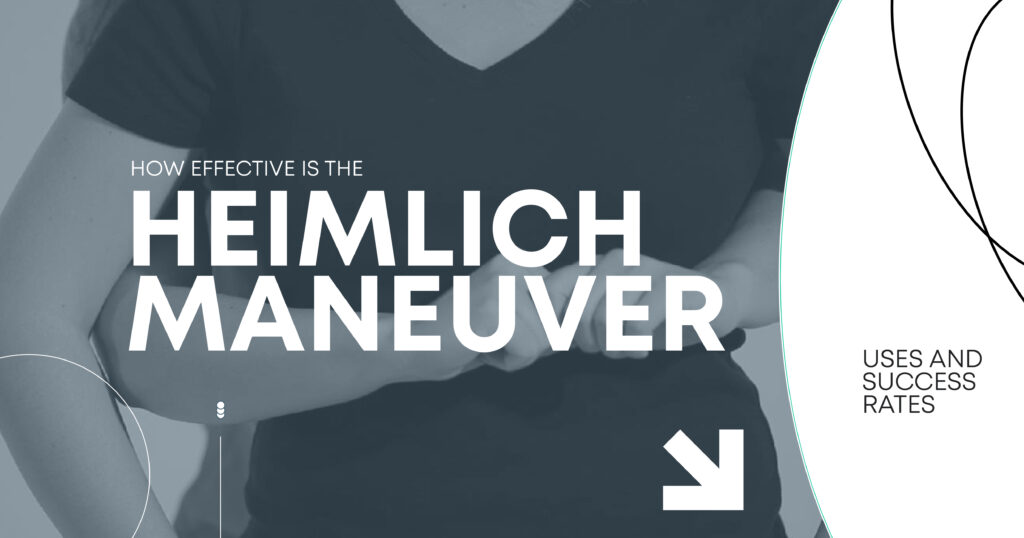Choking is one of the most common life-threatening emergencies, it can happen anywhere and at any time. The Heimlich maneuver is a lifesaving procedure intended to clear the airway and restore breathing to those who are choking.
Questions have arisen as to how effective the Heimlich maneuver is or how much of a success rate there is. This guide covers everything from the success rates to the variations of techniques used with detailed instructions, giving you the gift of knowing how to save lives.
Understanding the Heimlich Maneuver
What Is the Heimlich Maneuver?
The Heimlich maneuver is an abdominal thrust used in choking emergencies to clear airway obstructions. Dr. Henry Heimlich introduced it in 1974, and it has since been used worldwide to save innumerable lives by expelling foreign bodies from the windpipe.
It is endorsed by the American Heart Association and the American Red Cross and forms a core part of emergency training for healthcare providers, first responders, and bystanders.
How Does the Heimlich Maneuver Work?
The Heimlich technique uses air-pressure physics to remove an obstruction. The abdominal thrusts compress the diaphragm, the foremost dome-shaped breathing muscle, when applied. Compression by the high abdomen pushes air from the lungs at high pressure, similar to a powerful exhalation. That sudden rush of air goes toward the surface where the object is lodged, and so forth, driving it outwards from the airway.
The maneuver works best when there is a complete obstruction to airflow. For some partial blockages, for example, when air can still get through, it’s often suggested that the victim cough out the item themselves, as coughing is a natural and quite effective means of clearing it.
Does the Heimlich Maneuver Always Work?
While the Heimlich maneuver has a strong track record of success, it is not infallible. Various factors can influence its effectiveness:
- Severity of Obstruction. Complete blockages respond better than partial ones.
- Victim’s Condition. The individual’s age, size, and physical health may impact the technique’s success.
- Rescuer’s Skill. Proper execution is critical. Incorrect hand placement or insufficient force can limit effectiveness.
Research indicates that when correctly applied, the Heimlich maneuver can show a success rate close to 85%. However, uncommon complications or peculiar anatomical impediments might affect its effectiveness. Occasionally, supplemental maneuvers such as back blows, chest compressions, or, in some cases, advanced medical intervention may be needed.
Mental Health Center of San Diego
The History and Evolution of the Heimlich Maneuver
The Birth of a Life-Saving Technique
Choking was previously one of the highest causes of avoidable deaths, especially during meals, because of no effective first aid methods. Before learning about the Heimlich maneuver, the usual techniques for relieving choking were back slaps and jerky movements, which pushed the obstructions deeper into the airway.
In the 1970s, Dr. Henry Heimlich invented the Heimlich maneuver, an effective solution for preventing ingestive choking. This technique, possible through abdominal thrusts causing a sudden upward airflow, became very interesting because of its simplicity and effectiveness.
His publication initially appeared in medical journals and continued among first responders and soon-to-be healthcare professionals. By 1974, this intervention was finally considered revolutionary for managing choking emergencies.
Updates and Adaptations Over the Years
While the Heimlich maneuver became common in its application, it became essential for researchers and health professionals to tweak and adjust the technique so that it could work for different populations. Such amendments develop the effectiveness and safety of the maneuver in diverse situations:
- For Infants and Toddlers. The standard Heimlich maneuver was modified with back blows and chest thrusts rather than abdominal ones. This alternative adapts manipulation to account for the vulnerability of small anatomy and safely clears obstructions.
- For Pregnant Women. For women’s abdomen thrusts, rescuers may perform chest thrusts on an increased pregnant woman. This modification provides a greater safety margin while using this technique.
- For People With Obesity. The changes in hand placement involve moving above the torso to close the chest while considering the individual’s weight and the power to bust the block.
Impact on First Aid and Public Awareness
Dr. Heimlich’s invention has become the foundation of first aid training worldwide. Organizations like the American Red Cross and the American Heart Association now teach it to their students, spreading the word regarding the maneuver’s importance. As a result, public campaigns, educational videos, and even the media have popularized it as an essential lifesaving skill.
Apart from this, further research in the field has also established the efficacy of the maneuver and defined its scope. For example, while giving a complete obstruction, quite often, it is required to apply other methods or procedures in the hospital for more serious cases, like those involving an unconscious choking victim.
Modern-Day Legacy
The Heimlich maneuver is more than an action, it represents innovation in emergency care, and Dr. Heimlich’s legacy continues to inspire new advances in life-saving procedures. It stands true to show how much one person can change the face of world health and safety.
Step-by-Step Guide on How to Perform the Heimlich Maneuver
When to Use the Heimlich Maneuver
This maneuver is only appropriate for people with a complete airway obstruction. Signs of choking include the complete inability to speak, breathe, or cough along with the universal choking signal-hands clutching the throat. Incomplete obstructions, where the victim can cough or speak, tend to resolve themselves without intervention.
How to Perform an Emergency Heimlich Maneuver
In case of an emergency with the choking victim, position yourself behind them and encircle them at the waist with your hands. Then, place a fist with one hand just above the belly button. Cover the fist with your other hand to exert thrusts upward rapidly toward the diaphragm. Repeat as necessary until the object is dislodged or the victim resumes normal breathing.
Heimlich Maneuver on Self: What to Do If You’re Choking Alone
If you are by yourself and experience choking, then performing the Heimlich on yourself involves creating a similar upward thrust. Use a fist and press the abdomen forcefully with the other hand. You could also lean over a hard object like a chair or counter to press on the abdomen. If you’re choking alone, that difference can be between life and death.
Heimlich Maneuver for Pregnant Woman: Adjustments to Make
In case of choking in pregnant women, it is indicated to use chest thrusts instead of abdominal ones to avoid damaging the baby. Place the hands in the middle of the chest and push inward and upward. Learning the Heimlich maneuver for a pregnant woman thus guarantees both safety and effectiveness.
Special Techniques for Toddlers and Children
Children need a gentler massage when they are injured. The above-described methods will help a child get to the level of exerting similar upward pushes but with appropriate adjusted force. Proper technique prevents harm while ensuring that the object is effectively dislodged.
How to Do Maneuvers for Babies Safely
Babies need special treatment. Lay the baby’s face across the forearm while supporting the head and neck, and give five solid taps between the shoulder blades. If nothing comes out, turn the baby over and give two fingers worth of five chest compressions. Repeat this cycle to make sure the airway is cleared.
Performing the Heimlich Maneuver on People With Obesity
Abdominal thrusts will not be possible for severely obese individuals. For those persons, it is now using chest thrusts: hands center-most on the chest as you apply pressure inward and upward. This change puts the procedure in the practical category among all body types.
What to Do When the Choking Victim Becomes Unconscious
Transitioning From the Heimlich Maneuver to CPR
If the victim becomes unconscious, lay them flat on their back. Begin chest compressions immediately and alternate with airway checks to look for the obstructing object. Transitioning from the Heimlich maneuver to CPR increases the chances of survival.
Signs to Look For During Unconscious Choking
Look for signs like cyanosis (bluish skin) and the absence of breathing or pulse. These indicators confirm the severity of the situation and guide your next steps, including calling emergency services.
Mental Health Center of San Diego
Risks and Limitations of the Heimlich Maneuver
Who Shouldn’t Receive the Heimlich Maneuver?
Individuals with abdominal trauma, fragile bones, or other specific medical conditions may not be suitable for the Heimlich maneuver. Alternative methods, like back blows or chest thrusts, should be considered.
What Are the Risks of Performing the Heimlich Maneuver?
Potential risks include rib fractures, internal injuries, or bruising. These risks highlight the importance of applying the correct technique and force.
Importance of Learning the Heimlich Maneuver
How Heimlich Maneuver Videos Can Help You Master the Technique
Visual aids, such as Heimlich maneuver videos, provide step-by-step guidance for learning the procedure. Watching these resources ensures accuracy and boosts confidence in emergencies.
The Role of Quick Action in Saving Lives
Every second counts as a choking emergency. Quick action, combined with proper technique, significantly improves the chances of survival and minimizes long-term complications.
Enhancing Your Skills in Emergency Response
Common Mistakes to Avoid During the Heimlich Maneuver
Avoid errors like incorrect hand placement or hesitating during application. Practicing the maneuver helps eliminate these mistakes and ensures preparedness.
When to Call for Professional Medical Assistance
Even after clearing the airway, professional evaluation is essential to rule out complications. Always call emergency services if the victim experiences ongoing discomfort.
Call to Action:
The Heimlich maneuver is a life-saving skill that everyone should learn. Watch Heimlich maneuver videos, practice with family or friends, and share this essential knowledge. Equip yourself today to make a difference when it matters most because knowing how to perform an emergency could save a life. Don’t wait, act now!
Mental Health Center of San Diego
FAQ’s
- Can the Heimlich Maneuver Be Used on Pets?
If a pet is choking, the Heimlich maneuver can be modified for the animal. Different maneuvers exist for different kinds of dogs, depending on the size. After the incident, always have a vet check the pet.
- How Often Should You Practice the Heimlich Maneuver?
Routine proficiency develops muscle memory and confidence for effective performance during an emergency. You might consider reviewing the technique on an occasional basis, such as once a year or during the teaching of a first-aid course.
- Can the Heimlich Maneuver Cause Injury?
The Heimlich maneuver does help but can break ribs, bruise internal organs, and injure organs if used incorrectly. Unfortunately for the elderly, this population usually has frail bones and very delicate organs. Proper training should make it safe to use.
- Is the Heimlich Maneuver Effective for Drowning Victims?
There are ways to rescue someone from drowning, one of which is called the Heimlich maneuver, which is contraindicated in drowning while reestablishing oxygen with CPR, and rescue breathing is indicated. This necessitates immediate assistance from emergency personnel.
- What Should You Do If the Heimlich Maneuver Doesn’t Work?
After numerous unsuccessful attempts at the Heimlich maneuver, emergency assistance must be sought immediately. While continuing abdominal thrusts, the individual’s state should be monitored continuously. Unconsciousness would necessitate an immediate start of CPR, checking for an obstruction in the airway before attempting escape breaths.









